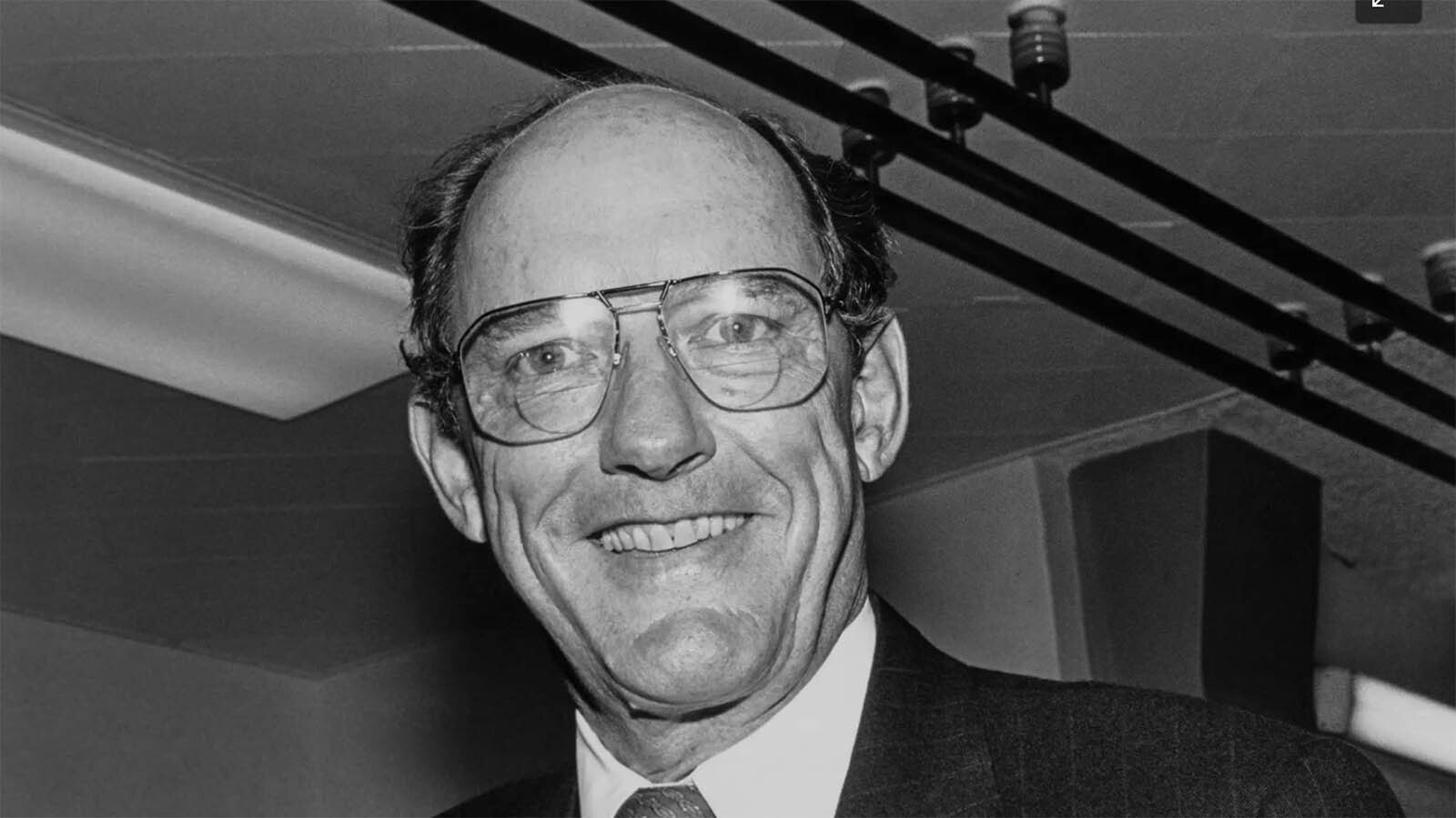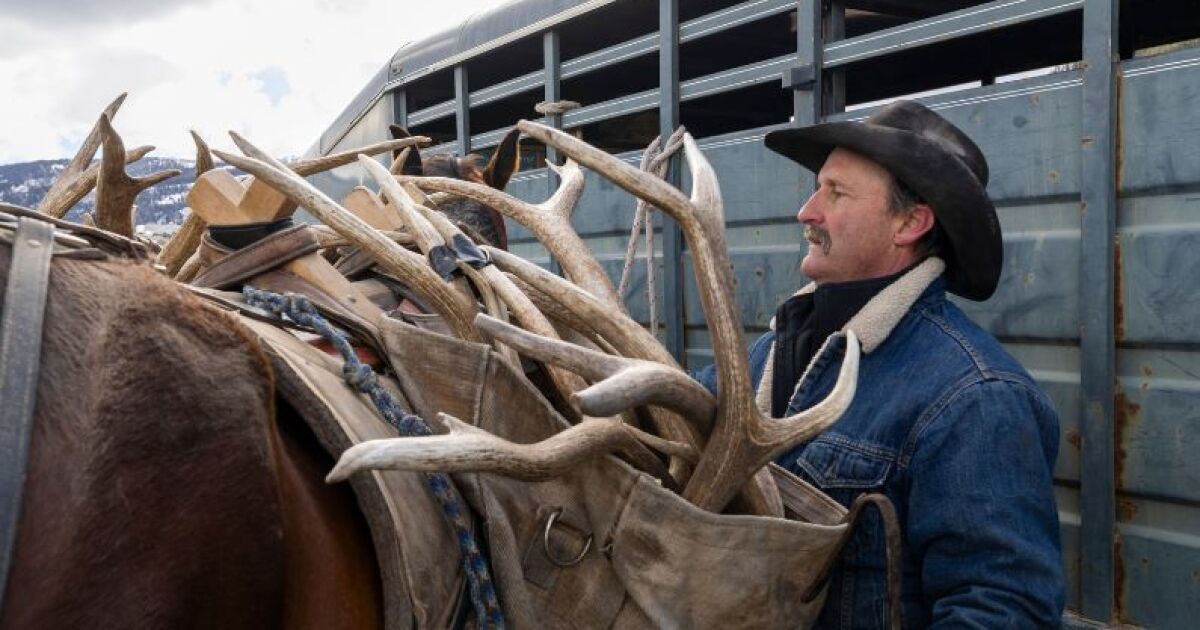Wyoming
Former US Sen. Malcolm Wallop: The Wyoming Rancher Who Helped Save Israel

An award-winning journalist credited the late President Ronald Reagan with saving Israel last weekend with the missile defense systems the United States built in the 1980s.
Wall Street Journal columnist Daniel Henninger praised the defensive effort in his Wednesday piece titled “Ronald Reagan Just Saved Israel From Iran’s Attack.” He also poked fun at President Joe Biden who, despite beaming over the effort’s success, was a critic of the defense project that led to it.
And that project — nicknamed “Star Wars” — owes its success to a Yale-educated rancher from Wyoming.
Sen. Malcolm Wallop, R-Wyoming, was an early leader of the Strategic Defense Initiative (SDI), a program to build weapons that could intercept and destroy ballistic missiles before they reached their targets.
He introduced the first of several amendments to the Defense Authorization Bill in 1980, which led to a provision of law directing the U.S. secretary of defense to build space laser weapons.
Wallop’s original plan was to build space lasers. As far as the public knows, the program didn’t yield space lasers. It did build an arsenal of ground-, air- and sea-based missile interceptors, which Israel quickly gained permission to develop alongside the United States.
“By universal acclamation, the hero of last weekend was Israel’s missile-defense systems,” Henninger wrote, referencing Iran’s 300-munition attack on Israel on April 13, which American and Israeli defense systems largely thwarted.
Everyone Deescalate
Reagan was campaigning for the presidency in 1980 and making bold statements about improving national defense and the failures of President Jimmy Carter’s peace efforts with the Union of Soviet Socialist Republics (USSR).
Three years later, March 23, 1983, Reagan publicly introduced the SDI program in a televised speech, calling it a tool for “free people (to) live secure in their knowledge that their security did not rest upon the threat of instant U.S. retaliation to deter a Soviet attack.”
But “behind closed doors,” Reagan also heeded politicians and bureaucrats pushing for arms control, the notion that nations can deescalate their arms development and adhere to weapon-limiting treaties, according to Wallop’s 1987 book “The Arms Control Delusion,” which he co-wrote with his staffer, international relations expert Angelo Codevilla.
Appointees who touted themselves as the D.C. establishment “called upon their raw bureaucratic power” and pressured Reagan to choose between their de-escalation strategies, and the host of unknown reactions the USSR could have to the development of robust American missile defense system, Wallop wrote.
Prodding The President
So Reagan vacillated between deescalating with the USSR (thereby limiting the United States’ defense production) and bolstering the Star Wars program.
Wallop was an outspoken critic of the president’s indecision. He coauthored a 1986 New York Times opinion piece with Rep. Jack Kemp, R-New York, blasting the president for “reportedly” offering to defer deployment of any American defenses against Soviet missiles for another five to seven years.
His book criticized the president for treating Star Wars like a research program or a bargaining chip, rather than an immediate response to the USSR’s daunting aspirations. He accused the president of “sugar-coating” his messaging to keep both the arms controllers in Washington, D.C., and the American people happy, while ignoring the realities of what war with the USSR would mean.
“The administration has consciously put off the time when Americans would have protective weapons, and … it has increased the chances of those weapons not working right,” Wallop wrote. He ridiculed the idea that mere treaties could influence Soviet behavior.
The Soviets contended between 1983 and 1985 that SDI was a threat to the USSR’s security, and that it was too expensive a program for the Soviets to keep pace in their own arms development.

Cold War Ends
Wallop was so intent on keeping Star Wars in place that he hopped from the influential Senate Finance Committee in early 1989 to the Armed Services Committee, where he remained into 1992, Wallop’s former chief of staff, Rob Wallace, told Cowboy State Daily on Thursday.
It was an unheard-of leap from the powerful Senate committee to a lesser one. Wallace called it a reflection of how serious the senator was about American defense systems.
“That probably reflects the time he was most worried about the commitment of the administration to the (SDI) initiative,” said Wallace.
SDI did stretch U.S. finances, but it contributed to the end of the Cold War, according to the Besa Center.
The Soviet Union could not keep up its arms race with the U.S., and it ultimately collapsed in the end of 1991.
Biden Not Safe From Criticism Either
Henninger’s column teases the current president, contrasting Biden’s recent praise of America’s role in shooting down Iranian missiles against Biden’s open mockery of Star Wars.
Biden insisted in a 1986 speech that Star Wars was reckless and irresponsible, and threatened arms-control agreements buttressing American security.
Wallop’s book also criticizes then-Sen. Joe Biden, D-Delaware, as a meddlesome defender of USSR interests who coaxed politicians into looking the other way when the Soviets broke international de-escalation pacts. Biden dwelled on technical aspects of those compacts to keep the U.S. from holding the Soviets responsible for their arming-up, Wallop wrote.
“Senator Biden has strongly expressed the wish, no doubt sincere, that he not be taken as the Soviet Union’s defender,” wrote Wallop. “But how else can one characterize his invitation not to be alarmed by activities that are clearly threatening to Americans, but that might possibly be shielded by some technicality?”

He Didn’t Buy MAD
Wallace remembers his former boss as “instrumental” in the SDI effort, as did another former Wallop chief of staff, retired Wyoming Supreme Court Justice Bill Hill.
Wallop pushed SDI so hard because he didn’t buy the strategy of mutual assured destruction (MAD), Wallace said.
Mutual assured destruction is the idea that if a nation launched nuclear missiles at another nation with nuclear capabilities, the stricken nation would counter-strike and inflict casualties and destruction so massive that no one would dare launch nuclear missiles in the first place.
“Malcolm thought, ‘That’s a really dumb idea,’” Wallace recalled.
The late senator’s book compares mutual assured destruction to some politicians’ technocratic hubris. Because a MAD fallout is almost incomprehensible, entertaining it logically made arms control even more tempting for some, he wrote.
The United States should not develop counterstrike weapons that could take out a quarter of the Soviet land mass, he wrote, adding that powerful defense systems were not only more effective at preserving humanity, but more ethical.
Wallop died at his home near Big Horn, Wyoming, in 2011 at age 78. The New York Times eulogized him as “a leading conservative light in Washington.”
Contact Clair McFarland at clair@cowboystatedaily.com

Clair McFarland can be reached at clair@cowboystatedaily.com.

Wyoming
Australia Company Targets 85 Million Pounds Of Uranium In Northeast Wyoming

To meet growing demand for uranium worldwide, Australian-based Peninsula Energy Ltd. said that it has begun construction on a central processing plant in northeastern Wyoming.
The company’s Ross processing plant will take uranium processed at other Peninsula-owned mines in northeastern Wyoming and produce yellowcake, which is then shipped to Illinois to turn into enriched fuel for nuclear reactors.
The fuel supply chain looks upbeat for Peninsula.
On Monday, Peninsula expanded its estimate for uranium underground in its flagship Lance project near Gillette by 7.8% to 58 million pounds.
The company also expanded its estimates for uranium deposits by 19.6% to 26.2 million pounds in its nearby Ross and Kendrick mines, also located in the northeastern Wyoming area.
“This resource growth comes at an opportune time with the United States government continuing to take meaningful action to reinvigorate its domestic uranium production and nuclear fuel cycle capacity, [while] the company continues preparing for the resumption of commercial production at our U.S.-based Lance projects,” said Wayne Heili, Peninsula’s managing director and CEO, in a prepared statement.
Uranium Going Nuclear
Several uranium companies in Wyoming are posturing for increased production of the commodity because of higher demand in the United States for nuclear fuel, especially since federal lawmakers have responded to Russia’s invasion of Ukraine by banning imports from Russia.
This month’s ban by Washington has spurred domestic development of nuclear fuel for reactors and led to many uranium mining companies to restart production in Wyoming and elsewhere.
Uranium spot prices hit $107 per pound in early February but have since backed off to about $91 a pound as of Monday, according to Atlanta-based UxC LLC, which tracks uranium spot prices on a nuclear fuel exchange.
Peninsula does business in Wyoming through its Strata Energy Inc. unit, which operates the Lance project near Gillette and other mines.
The Ross central processing facility is a key part of Peninsula’s supply chain in Wyoming.
“This is a key piece of the jigsaw for us, providing the ability to produce a finished product for our customers without having to rely on any third-party processing facilities,” Heili said.
“We remain confident of hitting our production targets for 2025,” he said.
Samuel Engineering Inc., with offices in Wyoming and Denver, was hired by Peninsula to get the project ready for restart of production before the end of 2024.
Double Capacity At Ross
The Ross plant was originally built in 2015 as an alkaline in-situ recovery facility capable of producing up to 1 million pounds annually of uranium. Samuel was hired to build additional plant facilities to expand production capacity to 2 million pounds.
Instead of digging up uranium in a mine or surface pit, Wyoming’s mining companies perform in-situ recovery of the mineral. This kind of operation involves pumping oxygenated water with an occasional addition of bicarbonate of soda into the ground to get at the uranium.
In-situ mining has low environmental impact.
In this process, the uranium is dissolved and pumped to the surface, where the mineral is stripped from the water. The water stripped of uranium is then returned underground.
In March, Peninsula agreed to sell between $88 million and $117 million worth of Wyoming uranium to a European nuclear fuel buyer from the Lance project.
To pay for restart of production at the Lance facility, Peninsula raised nearly $60 million in late 2023. Combined, the company plans to take uranium mined at the Kendrick, Barber and Dagger project in Crook County, Wyoming, and convert it to yellowcake at the Ross processing facility.
The agreement with the European buyer requires the company to sell 1.2 million pounds of uranium over a six-year period starting in 2028 to Synatom, which manages the supply of enriched uranium to Belgium’s nuclear power plants.
With the inclusion of this new sales agreement, the company’s total contractual sales obligation over the upcoming decade is 6 million pounds.
Pat Maio can be reached at pat@cowboystatedaily.com.
Wyoming
Pokes Football: Best of Wyoming – No. 25

LARAMIE — It’s officially “series season.”
This summer, with the help of some longtime Wyoming football followers, we will count down the Top 25 homegrown products in program history.
As always, what these guys did in professional football doesn’t matter. This is all about production in Laramie. A couple of the guys on this final list may not have been born here, but they grew up in Wyoming and graduated from a in-state high school.
Once we put a bow on these selections, we’ll move on to other states like Colorado, Nebraska, Texas, etc. You get the picture.
So, let’s get this party started:
Cory Talich/ UW courtesy photo
No. 25 – Cory Talich
Linebacker, 1990-93, Pine Bluffs, Wyo.
Résumé in Laramie
Cory Talich was named second-team All-Western Athletic Conference during his sophomore season in Laramie back in 1991. That year the Pine Bluffs product finished with 64 tackles, including 11 for loss. He also forced two fumbles and picked off a pass. Talich racked up 167 tackles during his tenure in Laramie. All but five of those stops came during his final three seasons. He brought down the ball carrier 16 times behind the line of scrimmage and capped his career with two quarterback sacks and three interceptions. Talich’s brother Jim also played linebacker for the Cowboys from 1994-97. His son Nathaniel suited up for the UW basketball team in 2022-23.
About Pine Bluffs
Just a stone’s throw from the Nebraska border on Interstate-80, Pine Bluffs is home to roughly 1,100 residents. The town is located in Laramie County, just 42 miles east of Cheyenne.
(Cody Tucker and Jared Newland both work for Townsquare Media, which owns 7220sports.com. Kevin McKinney has been a color commentator of Cowboy football for five decades. Ryan Thorburn now works for the University of Wyoming in a sports information role after spending decades in the newspaper industry, most recently at the Casper Star-Tribune. Sally Ann Shurmur, the daughter of former UW football coach Fritz Shurmur, is also a veteran of the newspaper industry, working as a journalist, columnist at the CST for 43 years. She currently writes for Cowboy State Daily.)
University of Wyoming’s Top 50 Football Players
The rules are simple: What was the player’s impact while in Laramie? That means NFL stats, draft status or any other accolade earned outside of UW is irrelevant when it comes to this list.
This isn’t a one-man job. This task called for a panel of experts. Joining 7220’s Cody Tucker are Robert Gagliardi, Jared Newland, Ryan Thorburn, and Kevin McKinney.
We all compiled our own list of 50 and let computer averages do the work. Think BCS — only we hope this catalog is fairer.
Gallery Credit: 7220Sports.com
– University of Wyoming’s Top 50 Football Players
Wyoming
Shed hunt season opener draws hundreds of Wyoming residents

The sun had yet to rise, and over a hundred cars, trucks, and trailers sat idling in the county fairgrounds parking lot and down the neighboring street. Hunters were drinking coffee, reaching for their toes to limber up and some — saddling horses.
Then, 20 minutes before the 6 AM start of Wyoming’s annual shed hunt, flashing police lights led the motorcade out of town toward the elk refuge.
Brady Rivenes and his five shed-hunting passengers were 23rd in line. As he drove, his black truck’s headlights shined on herds of elk. The 24-year-old from Gillette says the rush — or the chaos, as he put it — is hard to explain.
“Especially since it’s over something stupid like elk horns,” Rivenes said.
This is his fifth year driving the six and a half hours from Gillette for the shed hunt, and he knew where he was heading.
He quickly hung a right leaving the motorcade, peeled down a gravel road, veered over the edge of it, and lurched into park beneath looming canyon walls just outside of the refuge boundaries.
The group leaped out of the truck, swung packs over their shoulders, and broke into a sprint alongside other hunters — like the start of an Easter egg hunt for grown men clad in camo.
“It’s exhausting — this is the definition of type two fun,” Rivenes said.

Dante Filpula Ankney
/
KHOL
Shed antler hunting season in the state opened on May 1, and the annual shed hunt in Jackson usually draws hundreds of vehicles from around the country. They come to search for antlers, which elk shed around this time every year.
But, this year, only Wyoming residents can participate for the first week — because of a new state law. The legislation was largely spurred by calls from Wyoming shed hunters who felt they’d been pushed out by swarms of out-of-state hunters in recent years as the sport has grown in popularity. While competition was still fierce, there were fewer people this year.
Wyoming Game & Fish’s Brad Hovinga said the legislation cut the number of registrations in the Jackson area in half, from around 300 to about 120.
“And quite honestly, it was about as low-key as an antler collection opener than we’ve seen in years,” Hovinga said.
That’s because, in years past, Game and Fish has found hunters trying to get an advantage by sneaking out early, which is illegal. But this year, Hovinga said, law enforcement didn’t cite anyone for jumping the gun. He added that they checked licenses sporadically and didn’t find anyone violating the new law.
The law has been largely celebrated among Wyoming shed hunters, but he said the department has heard from many non-residents who felt the law—making them wait—is unfair because the large majority of antlers, at least in Jackson, will already be collected.
“Non-residents that show may have to hunt quite a bit harder than they have experienced in the past when they were allowed to start on the first of May,” Hovinga said.
Jase Romrell from Star Valley was out on the opening day. He said he’s a fan of the law.
“It’s more special this year because we can actually benefit from being Wyoming residents,” Romrell said. “It makes me feel proud to come and pick up the antlers that you watch all winter and see on the refuge.”
Sitting atop his horse with multiple antlers slung to its side, he said this year is also special since his sons are joining him for the first time.

Dante Filpula Ankney
/
KHOL
“My goal was to get the twins, my two boys, an antler, and they both succeeded in that,” Romrell said. “I just wanted to put a smile on their faces and make them enjoy the outdoors as much as I do.”
He’s been shed hunting in Jackson for about 10 years.
“We enjoy looking at them. We enjoy using them in home decor,” Romrell said. “They’re special to us because it’s a Western living style.”
Brady Rivenes, the 24-year-old from Gillette, said he has mixed feelings about the new law.
“Yeah, I kind of go both ways,” he said. “It’s cool getting to see all the Wyoming guys get their first pick on horns but also kind of bittersweet because you don’t get to see all of your out-of-state buddies you’ve made from coming to this over the years.”
Back on the mountain, Rivenes ran up a rocky cliff to a ridge line that plateaus. The chaos he had prepped for earlier had come to fruition. He occasionally tripped on the uneven game trails as he scanned the hillside for antler points. The sunrise cast a pink glow above the Tetons and glistened off the thin snow crust.
“They’re hard to see in snow,” Rivenes said as he tried to catch his breath.
Moving fast, with no plans of stopping, he knew other hunters were right behind him. He was looking for pockets or clusters of many antlers he had had luck finding in previous years.
“Some years you find it, some years you don’t,” Rivenes said, “but either way, we’re not stopping.
Then, his pace quickened, and he yelled as he spotted one — then two. He scrambled to their side, threw off his pack, strapped them in, and, with no time to celebrate, kept moving.
He was unsatisfied.
“Not good enough,” he said. “From where we went through and to only have two — it’s surprising.”
By the end of the day, he’ll have added two more. His friends, who had all spread out, found another four.
Ultimately, it was “not too shabby,” Rivenes said.

Dante Filpula Ankney
/
KHOL
He’s had better years, but ultimately, it’s not just the thrill, the sheds, or the scenery that keeps him coming back.
“A lot of it’s the people,” he said. “We like to shed hunt, there’s sheds on this hill, everyone else gets to come together that likes to shed hunt and you get to see all those guys pick up horns, it’s just a good time in general.”
Rivenes returned to his truck and threw down his sheds, considered their size alongside the others, and debriefed the day cordially with other returning hunters. The competition was over.
He drove the gravel road out until he met the paved streets in town, grabbed a quick lunch at a local restaurant, and then hit the road back towards Gillette — all before noon.
Copyright 2024 KHOL.
That story was shared with KSUT via Rocky Mountain Community Radio, a network of public media stations in Colorado, Wyoming, Utah, and New Mexico, including KSUT
-

 Education1 week ago
Education1 week agoHow Counterprotesters at U.C.L.A. Provoked Violence, Unchecked for Hours
-

 World1 week ago
World1 week agoBrussels, my love? Champage cracked open to celebrate the Big Bang
-

 Politics1 week ago
Politics1 week agoAustralian lawmakers send letter urging Biden to drop case against Julian Assange on World Press Freedom Day
-

 Politics1 week ago
Politics1 week agoHouse Dems seeking re-election seemingly reverse course, call on Biden to 'bring order to the southern border'
-
News1 week ago
A group of Republicans has united to defend the legitimacy of US elections and those who run them
-

 World1 week ago
World1 week ago‘It’s going to be worse’: Brazil braces for more pain amid record flooding
-

 Politics1 week ago
Politics1 week ago'Stop the invasion': Migrant flights in battleground state ignite bipartisan backlash from lawmakers
-

 World1 week ago
World1 week agoGerman socialist candidate attacked before EU elections













